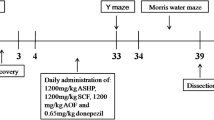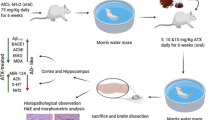Abstract
Alzheimer’s disease (AD) severely threatens human health in their old age, however the potential etiology underlying it is still unclear. Both Ginsenoside Rg1 (GRg1) and Acori graminei Rhizoma (AGR) are the traditional Chinese herbal drug, while their potential role in AD remains need further identification. Both SAMP1 and SAMP8 mice were employed as the control and AD mice. Morris water maze method was used to detect the cognitive function of the mice, TUNEL assay was performed to determine cell apoptosis. Real-time PCR and western blot were carried out to measure gene expression. The relationship between miR-873-5p and HMOX1 was determined using luciferase reporter assay. Comparing with SAMP1, the cognitive function was impaired and cell apoptosis was increased in SAMP8 mice. GRg1 + AGR treatment significantly attenuated the symptom of AD. The expression of miR-873-5p was decreased, while HMOX1 was increased in SAMP8 mice. GRg1 + AGR treatment significantly promoted the expression of miR-873-5p, but decreased HMOX1. MiR-873-5p targets HMOX1 to regulate its expression. Aβ1–42 stimulation decreased the expression of miR-873-5p, but increased HMOX1 in PC12 cells. GRg1 + AGR treatment reversed the effect of Aβ1–42, while miR-873-5p inhibitor abolished the effect of GRg1 + AGR. In vivo experiments confirmed the protect role of GRg1 + AGR in AD. GRg1 + AGR suppressed neuron cell apoptosis by regulating the expression of miR-873-5p in AD.







Similar content being viewed by others
References
Klyubin I, Nicoll AJ, Khalili-Shirazi A, Farmer M, Canning S, Mably A et al (2014) Peripheral administration of a humanized anti-PrP antibody blocks Alzheimer’s disease Abeta synaptotoxicity. J Neurosci 34:6140–6145
Che H, Du L, Cong P, Tao S, Ding N, Wu F et al (2017) Cerebrosides from sea cucumber protect against oxidative Stress in SAMP8 Mice and PC12 Cells. J Med Food 20:392–402
Busciglio J, Lorenzo A, Yeh J, Yankner BA (1995) beta-Amyloid fibrils induce tau phosphorylation and loss of microtubule binding. Neuron 14:879–888
Khan A, Vaibhav K, Javed H, Khan MM, Tabassum R, Ahmed ME et al (2012) Attenuation of Abeta-induced neurotoxicity by thymoquinone via inhibition of mitochondrial dysfunction and oxidative stress. Mol Cell Biochem 369:55–65
Sagy-Bross C, Hadad N, Levy R (2013) Cytosolic phospholipase A2alpha upregulation mediates apoptotic neuronal death induced by aggregated amyloid-beta peptide1-42. Neurochem Int 63:541–550
Russo I, Caracciolo L, Tweedie D, Choi SH, Greig NH, Barlati S et al (2012) 3,6′-Dithiothalidomide, a new TNF-alpha synthesis inhibitor, attenuates the effect of Abeta1-42 intracerebroventricular injection on hippocampal neurogenesis and memory deficit. J Neurochem 122:1181–1192
Li SL, Gao HL, Lv XK, Hei YR, Li PZ, Zhang JX et al (2017) MicroRNA-124 inhibits cell invasion and epithelial-mesenchymal transition by directly repressing Snail2 in gastric cancer. Eur Rev Med Pharmacol Sci 21:3389–3396
Cui C, Shi X (2017) miR-187 inhibits tumor growth and invasion by directly targeting MAPK12 in osteosarcoma. Exp Ther Med 14:1045–1050
Yuan J, Chen H, Ge D, Xu Y, Xu H, Yang Y et al (2017) Mir-21 promotes cardiac fibrosis after myocardial infarction via targeting Smad7. Cell Physiol Biochem 42:2207–2219
Huang Y, Tang S, Ji-Yan C, Huang C, Li J, Cai AP et al (2017) Circulating miR-92a expression level in patients with essential hypertension: a potential marker of atherosclerosis. J Hum Hypertens 31:200–205
Alsharafi WA, Xiao B, Li J (2016) MicroRNA-139-5p negatively regulates NR2A-containing NMDA receptor in the rat pilocarpine model and patients with temporal lobe epilepsy. Epilepsia 57:1931–1940
Song J, Kim YK (2017) Identification of the role of miR-142-5p in Alzheimer’s disease by comparative bioinformatics and cellular analysis. Front Mol Neurosci 10:227
Arena A, Iyer AM, Milenkovic I, Kovacs GG, Ferrer I, Perluigi M et al (2017) Developmental expression and dysregulation of miR-146a and miR-155 in Down’s syndrome and mouse models of Down’s syndrome and Alzheimer’s disease. Curr Alzheimer Res 14(12):1305–1317
Zhou C, Zhao L, Zheng J, Wang K, Deng H, Liu P et al (2017) MicroRNA-144 modulates oxidative stress tolerance in SH-SY5Y cells by regulating nuclear factor erythroid 2-related factor 2-glutathione axis. Neurosci Lett 655:21–27
Bhatt NP, Park JY, Lee HJ, Kim SS, Kwon YS, Chun W (2017) Apocynin protects mesangial cells from lipopolysaccharide-induced inflammation by exerting heme oxygenase 1-mediated monocyte chemoattractant protein-1 suppression. Int J Mol Med 40(4):1294–1301
Lu H, Li Y, Zhang T, Liu M, Chi Y, Liu S et al (2017) Salidroside reduces high-glucose-induced podocyte apoptosis and oxidative stress via upregulating heme oxygenase-1 (HO-1) expression. Med Sci Monit 23:4067–4076
Carasi P, Rodriguez E, da Costa V, Frigerio S, Brossard N, Noya V et al (2017) Heme-oxygenase-1 expression contributes to the immunoregulation induced by Fasciola hepatica and promotes infection. Front Immunol 8:883
Hettiarachchi NT, Boyle JP, Dallas ML, Al-Owais MM, Scragg JL, Peers C (2017) Heme oxygenase-1 derived carbon monoxide suppresses Abeta1-42 toxicity in astrocytes. Cell Death Dis 8:e2884
Gupta A, Lacoste B, Pistell PJ, Ingram DK, Hamel E, Alaoui-Jamali MA et al (2014) Neurotherapeutic effects of novel HO-1 inhibitors in vitro and in a transgenic mouse model of Alzheimer’s disease. J Neurochem 131:778–790
Sung HY, Choi BO, Jeong JH, Kong KA, Hwang J, Ahn JH (2016) Amyloid beta-mediated hypomethylation of heme oxygenase 1 correlates with cognitive impairment in Alzheimer’s disease. PLoS ONE 11:e0153156
Mao QQ, Huang Z, Zhong XM, Feng CR, Pan AJ, Li ZY et al (2010) Effects of SYJN, a Chinese herbal formula, on chronic unpredictable stress-induced changes in behavior and brain BDNF in rats. J Ethnopharmacol 128:336–341
Du Q, Jerz G, Waibel R, Winterhalter P (2003) Isolation of dammarane saponins from Panax notoginseng by high-speed counter-current chromatography. J Chromatogr A 1008:173–180
Zhao BS, Liu Y, Gao XY, Zhai HQ, Guo JY, Wang XY (2014) Effects of ginsenoside Rg1 on the expression of toll-like receptor 3, 4 and their signalling transduction factors in the NG108-15 murine neuroglial cell line. Molecules 19:16925–16936
Ma Y, Tian S, Sun L, Yao S, Liang Z, Li S et al (2015) The effect of acori graminei rhizoma and extract fractions on spatial memory and hippocampal neurogenesis in amyloid beta 1–42 injected mice. CNS Neurol Disord Drug Targets 14:411–420
Del Valle J, Duran-Vilaregut J, Manich G, Casadesus G, Smith MA, Camins A et al (2010) Early amyloid accumulation in the hippocampus of SAMP8 mice. J Alzheimers Dis 19:1303–1315
Currais A, Farrokhi C, Dargusch R, Armando A, Quehenberger O, Schubert D et al (2017) Fisetin reduces the impact of aging on behavior and physiology in the rapidly aging SAMP8 mouse. J Gerontol A 73:299–307
Huang JL, Jing X, Tian X, Qin MC, Xu ZH, Wu DP et al (2017) Neuroprotective properties of Panax notoginseng saponins via preventing oxidative stress injury in SAMP8 mice. Evid Based Complement Altern Med 2017:8713561
Castano-Prat P, Perez-Zabalza M, Perez-Mendez L, Escorihuela RM, Sanchez-Vives MV (2017) Slow and fast neocortical oscillations in the senescence-accelerated mouse model SAMP8. Front Aging Neurosci 9:141
Bai R, Yang Q, Xi R, Li L, Shi D, Chen K (2017) miR-941 as a promising biomarker for acute coronary syndrome. BMC Cardiovasc Disord 17:227
Darabi F, Aghaei M, Movahedian A, Pourmoghadas A, Sarrafzadegan N (2016) The role of serum levels of microRNA-21 and matrix metalloproteinase-9 in patients with acute coronary syndrome. Mol Cell Biochem 422:51–60
Liu W, Hu J, Zhou K, Chen F, Wang Z, Liao B et al (2017) Serum exosomal miR-125b is a novel prognostic marker for hepatocellular carcinoma. OncoTargets Ther 10:3843–3851
Tang J, Li Y, Liu K, Zhu Q, Yang WH, Xiong LK et al (2018) Exosomal miR-9-3p suppresses HBGF-5 expression and is a functional biomarker in hepatocellular carcinoma. Min Med 109(1):15–23
Cook JR, MacIntyre DA, Samara E, Kim SH, Singh N, Johnson MR et al (2015) Exogenous oxytocin modulates human myometrial microRNAs. Am J Obstet Gynecol 213:65 e1–65 e9
Liu X, Wu Y, Huang Q, Zou D, Qin W, Chen Z (2015) Grouping pentylenetetrazol-induced epileptic rats according to memory impairment and microRNA expression profiles in the hippocampus. PLoS ONE 10:e0126123
WHO (2008) Policy guidelines for collaborative TB and HIV services for injecting and other drug users: an integrated approach. WHO, Geneva
Wang DJ, Li QY, Xu SJ, Zeng N (2011) Effect of ginsenoside Rg1 on angiogenesis after neonatal hypoxia ischemia brain damage in rats. Sichuan Da Xue Xue Bao Yi Xue Ban 42:503–507
Limon ID, Mendieta L, Diaz A, Chamorro G, Espinosa B, Zenteno E et al (2009) Neuroprotective effect of alpha-asarone on spatial memory and nitric oxide levels in rats injected with amyloid-beta ((25–35)). Neurosci Lett 453:98–103
Yang Y, Geldmacher DS, Herrup K (2001) DNA replication precedes neuronal cell death in Alzheimer’s disease. J Neurosci 21:2661–2668
Xing HY, Li B, Peng D, Wang CY, Wang GY, Li P et al (2017) A novel monoclonal antibody against the N-terminus of Abeta1-42 reduces plaques and improves cognition in a mouse model of Alzheimer’s disease. PLoS ONE 12:e0180076
Acknowledgements
This work was supported by the Grant of Shandong Natural Science Funds (No. zr2014hl034) and Development Project of Science and Technology of Chinese Medicine in Shandong Province (No. 2015-286).
Author information
Authors and Affiliations
Corresponding author
Rights and permissions
About this article
Cite this article
Shi, R., Zhang, S., Cheng, G. et al. Ginsenoside Rg1 and Acori Graminei Rhizoma Attenuates Neuron Cell Apoptosis by Promoting the Expression of miR-873-5p in Alzheimer’s Disease. Neurochem Res 43, 1529–1538 (2018). https://doi.org/10.1007/s11064-018-2567-y
Received:
Revised:
Accepted:
Published:
Issue Date:
DOI: https://doi.org/10.1007/s11064-018-2567-y




